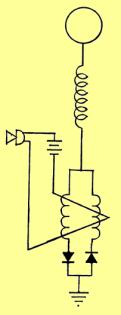Magnetic Amplifiers by The U.S. Navy (Author), George B. Trinkaus (Editor) Click for PDF
The basic magnetic amplifier has a transformer-like construction with two coupled AC (power) outputs and a DC (control) input applied to the separate winding. The DC (control) input can then be used to modulate the AC current by its affect on the magnetism in the transformer core. This can give us modulation, switching, pulse-generation, inversion, conversion, multivibrators, phase shift, and multiply. Mag amps require zero maintenance, can be made indestructible and EMP-proof, and can handle up to 200,000 amperes. All the things done by a transistor or a valve/tube and more. It’s very simple, but brilliant.
The DC (control) input can then be used to modulate the AC current by its affect on the magnetism in the transformer core. This can give us modulation, switching, pulse-generation, inversion, conversion, multivibrators, phase shift, and multiply. Mag amps require zero maintenance, can be made indestructible and EMP-proof, and can handle up to 200,000 amperes. All the things done by a transistor or a valve/tube and more. It’s very simple, but brilliant.
See also:http://teslapress.com/magamp.html
Wikipedia ‘Magnetic amplifier’
The magnetic amplifier (colloquially known as a “Mag Amp”) is an electromagnetic  device for amplifying electrical signals. The magnetic amplifier was invented early in the 20th century, (19th century actually) and was used as an alternative to vacuum tube amplifiers where robustness and high current capacity were required. World War II Germany perfected this type of amplifier, and it was used in the V-2 rocket. The magnetic amplifier was most prominent in power control and low-frequency signal applications from 1947 to about 1957, when the transistor began to supplant it.[1] The magnetic amplifier has now been largely superseded by the transistor-based amplifier, except in a few safety critical, high-reliability or extremely demanding applications. Combinations of transistor and mag-amp techniques are still used.
device for amplifying electrical signals. The magnetic amplifier was invented early in the 20th century, (19th century actually) and was used as an alternative to vacuum tube amplifiers where robustness and high current capacity were required. World War II Germany perfected this type of amplifier, and it was used in the V-2 rocket. The magnetic amplifier was most prominent in power control and low-frequency signal applications from 1947 to about 1957, when the transistor began to supplant it.[1] The magnetic amplifier has now been largely superseded by the transistor-based amplifier, except in a few safety critical, high-reliability or extremely demanding applications. Combinations of transistor and mag-amp techniques are still used.
Usage in computing
Magnetic amplifiers were widely studied during the 1950s as a potential switching element for mainframe computers. Mag amps could be used to sum several inputs in a single core, which was useful in the arithmetic logic unit (ALU). Custom tubes could do the same, but transistors could not, so the mag amp was able to combine the advantages of tubes and transistors in an era when the latter were expensive and unreliable.
The principles of magnetic amplifiers were applied non linearly to create magnetic digital logic gates. That era was short, lasting from the mid-1950s to about 1960, when new fabrication techniques produced great improvements in transistors and dramatically lowered their cost. Only one large-scale mag amp machine was put into production, the UNIVAC Solid State, but a number of contemporary late-1950s/early-1960s computers used the technology, like the Ferranti Orion and the English Electric KDF9, or the one-off MAGSTEC. The best known type of this is magnetic core memory. https://en.wikipedia.org/wiki/Magnetic_amplifier
teslapress.com: “The magnetic amplifier is not new; the principles of the saturable-core control were used in electrical machinery as early as 1885 although they were not identified as such. Saturable-core devices have been used, principally in heavy electrical machinery, in the U.S. since 1900. ” http://teslapress.com/magamp.html
Over Unity Free Energy
From Mag Amp to the MEG the Motionless Electromagnetic Generator 
The mag amp has given inspiration to some colourful technology, the MEG Motionless Electromagnetic Generator United States Patent 6,362,718 Patrick , et al. March 26, 2002 is just one example of using a technology that has been around since the 19th century.

Using the link below, the video on the page shows just how far researchers at Magnetic Energy Ltd have developed the idea: http://www.40billion.com/company/542335585
At Rex Research we see the MEG development work of Stephen Patric, Thomas Bearden and others and their over-unity claim that more comes out than goes in. At the bottom of the page is the not unexpected debunking by mainstream science – ‘In Disdain of Garbage Physics’ PDF by Shawn Bishop of Simon Fraser University. http://www.rexresearch.com/meg/meg-debunked.pdf
I find it interesting in that Bishop discusses the duplication and testing of the design by Jean-Louis Naudin. Bishop’s debunking creates a straw man when he tells us that Naudin’s work is probably fraudulent. Bishop’s proof, using math that would normally be used for a transformer, but the MEG is not a transformer and does not work like a transformer. In the video at the link above we see that the magnetism switches from the left to right of the core as the control windings energise. Transformers don’t work like this. There is no theory, math’ or scientific experimental research to explain the effect or to back-up the claim of fraud. Therefore Bishop does not and cannot have a clue what he is talking about.
Bishop is using the trick that all scientists must learn: If you don’t know what you are talking about, talk about something you do know about and apply it to the unknown. This keeps everything in the tightly sealed box that is academic science. The skeptics love it and swallow it whole, regurgitate it and pass it on as good science ‘fact’. It’s not science and it’s not fact.
Read it at: http://www.rexresearch.com/meg/meg.htm